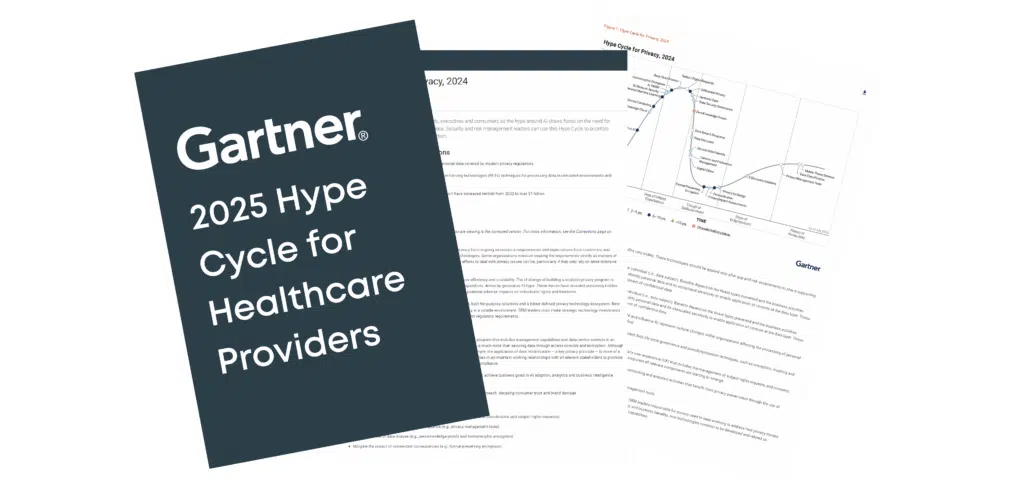The pace at which technology shifts can make it nearly impossible for leaders to keep up. To help, industry analysts Gartner create annual Hype Cycles designed to give CEOs and CIOs the insight they need to understand the potential impact of tech innovations.
Take a more detailed look at how Hype Cycles can inform business decisions effectively.
In 2025, healthcare is at a pivotal crossroads. The combination of artificial intelligence, data platforms, and digital health ecosystems is unlocking unprecedented opportunities to transform care delivery.
But with this transformation comes a critical challenge: how to innovate responsibly while safeguarding patient trust.
Throughout the latest Gartner Hype Cycle for Healthcare Providers, one thing is clear: data is at the heart of driving innovation within healthcare. And without clear data governance, interoperability and patient consent, digital health transformation will struggle to become reality.
The latest Gartner Hype Cycle for Healthcare Providers offers a comprehensive view of the technologies shaping this future. While the full report covers over 30 innovations, this article spotlights the technologies where data privacy, interoperability, and consent management are foundational to success.
“In 2025, healthcare providers will continue to face substantial macroeconomic challenges that increase the pressure on hospitals and health systems. Clinician burnout and workforce shortages persist as ongoing challenges in an industry where consumers have high expectations. By combining foundational and emerging technologies, healthcare providers can seize transformational opportunities to deliver results that address these challenges.”
Gartner Hype Cycle for Healthcare Providers, 2025
- Why privacy, interoperability, and consent matter now
- 7 technologies to watch as we move into 2026
- Agentic AI in Healthcare and Life Sciences
- Health Data Management Platforms (HDMPs)
- AI Governance in Healthcare and Life Sciences
- Consent Management for Healthcare
- Data Fabric in Healthcare
- API Management for Healthcare
- Semantic Interoperability
Why privacy, interoperability, and consent matter now
Healthcare organizations are under pressure from all sides:
- Regulators are tightening data protection laws (e.g., GDPR, HIPAA, EHDS, alongside 20+ state-level regulations) alongside stronger calls for interoperability and FHIR standards.
- Consumers are demanding transparency and control over their health data. Recent data breaches and compliance fines are creating mistrust.
- Innovators are building AI-driven systems that rely on massive, sensitive datasets.
- Systems are making it nearly impossible to innovate, with siloed data and fragmented integrations that don’t communicate properly for no single source of truth.
In this environment, technologies that enable secure, ethical, and interoperable data use are no longer optional but strategic differentiators.
7 technologies to watch as we move into 2026
Agentic AI in Healthcare and Life Sciences
Stage: Embryonic | Benefit: Transformational
What it is: AI agents that autonomously plan and execute complex clinical and administrative workflows.
Why it matters: Automates tasks like prior authorization, clinical documentation, and research workflows.
Privacy & governance: Raises significant concerns around autonomy, explainability, and data leakage. Requires robust AI governance frameworks and human oversight.
Interoperability: Must integrate with EHRs, CRMs, and research systems, demanding high levels of data standardization.
“Trust is a significant barrier to adoption. Without clear governance, agentic AI risks undermining confidence in clinical decision-making.”
Health Data Management Platforms (HDMPs)
Stage: Adolescent | Benefit: Transformational
What it is: Cloud-native platforms that orchestrate real-time, interoperable health data exchange.
Why it matters: Enables AI at scale, personalized care, and seamless data sharing across systems.
Privacy & Consent: Must support granular consent, data lineage, and regulatory compliance across jurisdictions.
Interoperability: Built on FHIR and data fabric principles, HDMPs are the backbone of composable digital health.
AI Governance in Healthcare and Life Sciences
Stage: Emerging | Benefit: High
What it is: Frameworks and tools to ensure ethical, compliant, and explainable AI use.
Why it matters: As AI adoption accelerates, governance ensures trust, transparency, and accountability.
Privacy & Risk: Addresses bias mitigation, model drift, and regulatory alignment.
Organizational Impact: Encourages cross-functional collaboration between clinical, legal, and IT teams.
Consent Management for Healthcare
Stage: Adolescent | Benefit: Moderate
What it is: Systems that allow patients to dynamically manage how their data is accessed and shared.
Why it matters: Empowers patients, supports research, and ensures compliance with evolving privacy laws.
Key Features:
- Granular, real-time consent updates
- Integration with HIEs and patient portals
- Support for cross-border data sharing
“Consent is no longer a checkbox—it’s a dynamic, patient-driven process that must be embedded across the data lifecycle.”
Data Fabric in Healthcare
Stage: Emerging | Benefit: Transformational
What it is: A design approach for flexible, reusable data integration across platforms and use cases.
Why it matters: Reduces manual integration, accelerates AI deployment, and supports composable architectures.
Privacy & Compliance: Must honor data sovereignty and individual consent at the data element level.
Interoperability: Offers an alternative to traditional point-to-point interfaces.
API Management for Healthcare
Stage: Mature Mainstream | Benefit: High
What it is: Platforms for creating, securing, and managing APIs across the healthcare ecosystem.
Why it matters: Enables real-time, secure data exchange with payers, partners, and patients.
Privacy & Security: Must comply with HIPAA, GDPR, and local data residency laws.
Interoperability: Critical enabler of FHIR-based data sharing and digital health platforms.
Semantic Interoperability
Stage: Adolescent | Benefit: High
What it is: The ability of systems to exchange data with shared meaning using standardized vocabularies.
Why it matters: Essential for care coordination, population health, and AI accuracy.
Challenges:
- Low vendor incentives to adopt standards
- Legacy systems still reliant on syntactic (not semantic) exchange
Strategic Priority: Invest in FHIR, SNOMED CT, and LOINC to future-proof your data ecosystem.
What Healthcare leaders must do now
- Build trust through transparency
Communicate clearly with patients about how their data is used.
Involve patient advisory groups in technology decisions. - Invest in Governance and Literacy
Establish cross-functional AI and data governance councils.
Train staff on privacy, consent, and responsible AI use. - Modernize your architecture
Move toward composable platforms and cloud-native data fabrics.
Prioritize interoperability and API-first strategies. - Choose vendors strategically
Look for partners with proven experience in privacy-aware, interoperable, and consent-driven solutions.
Final thoughts: Redefining the relationship between providers and people
The technologies highlighted in the 2025 Gartner Hype Cycle are not just about efficiency or automation, they are about redefining the relationship between healthcare providers and the people they serve.
As we embrace AI, data platforms, and digital ecosystems, we must do so with a commitment to privacy, transparency, and trust.
Ready to explore all 30+ technologies shaping the future of healthcare? Download the full Gartner 2025 Hype Cycle for Healthcare Providers.

Exclusive access to the latest Gartner Hype Cycle for Healthcare Providers
Ready to explore all 30+ technologies shaping the future of healthcare? We’re pleased to offer exclusive access for a limited time, usually only available to Gartner clients.

